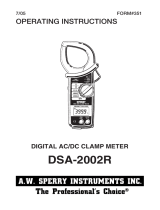
HT401
EN - 1
Table of contents:
1.PRECAUTIONS AND SAFETY MEASURES ............................................................... 2
1.1.Preliminary instructions ..................................................................................................... 2
1.2.During use ......................................................................................................................... 3
1.3.After use ............................................................................................................................ 3
1.4.Definition of measurement (overvoltage) category ............................................................ 3
2.GENERAL DESCRIPTION ........................................................................................... 4
2.1.Measuring average values and TRMS values ................................................................... 4
2.2.Definition of true root mean square value and crest factor ................................................ 4
3.PREPARATION FOR USE ........................................................................................... 5
3.1.Initial checks ...................................................................................................................... 5
3.2.Instrument power supply ................................................................................................... 5
3.3.Calibration ......................................................................................................................... 5
3.4.Storage .............................................................................................................................. 5
4.OPERATING INSTRUCTIONS ..................................................................................... 6
4.1.Instrument description ....................................................................................................... 6
4.1.1.Description of the controls ................................................................................................................. 6
4.2.Description of function keys .............................................................................................. 7
4.2.1.RANGE key ....................................................................................................................................... 7
4.2.2.VoltSense key .................................................................................................................................... 7
4.2.3.MIN MAX key ..................................................................................................................................... 7
4.2.4.SMART HOLD key ............................................................................................................................. 7
4.2.5.Backlight key ............................................................................................................................... 7
4.2.6.MODE key ......................................................................................................................................... 7
4.3.Internal modes of instrument ............................................................................................. 8
4.3.1.PEAK/HOLD mode ............................................................................................................................ 8
4.3.2.AC+DC mode ..................................................................................................................................... 8
4.3.3.AutoV LoZ mode ................................................................................................................................ 8
4.3.4.Disabling the Auto Power OFF function ............................................................................................. 8
4.3.5.Wrong insertion indication ................................................................................................................. 8
4.4.Operating instructions ....................................................................................................... 9
4.4.1.DC Voltage measurement ................................................................................................................. 9
4.4.2.AC Voltage measurement and Frequency ....................................................................................... 10
4.4.3.AC Voltage measurement with low input impedance ...................................................................... 11
4.4.4.DC Current measurement ................................................................................................................ 12
4.4.5.AC Current measurement and Frequency ....................................................................................... 13
4.4.6.Resistance measurement ................................................................................................................ 14
4.4.7.Diode and Continuity test ................................................................................................................. 15
4.4.8.Capacitance measurement .............................................................................................................. 16
4.4.9.Temperature measurement ............................................................................................................. 17
5.MAINTENANCE ......................................................................................................... 18
5.1.Battery and fuses replacement ........................................................................................ 18
5.2.Cleaning the instrument .................................................................................................. 18
5.3.End of life ........................................................................................................................ 18
6.TECHNICAL SPECIFICATIONS ................................................................................ 19
6.1.Technical characteristics ................................................................................................. 19
6.1.1.Electrical characteristics .................................................................................................................. 21
6.1.2.Reference standards ....................................................................................................................... 21
6.1.3.General characteristics .................................................................................................................... 21
6.2.Environment .................................................................................................................... 22
6.2.1.Environmental conditions for use ..................................................................................................... 22
6.3.Accessories ..................................................................................................................... 22
6.3.1.Standard accessories ...................................................................................................................... 22
6.3.2.Optional accessories ....................................................................................................................... 22
7.SERVICE .................................................................................................................... 23
7.1.Warranty conditions ......................................................................................................... 23
7.2.Service ............................................................................................................................ 23

























